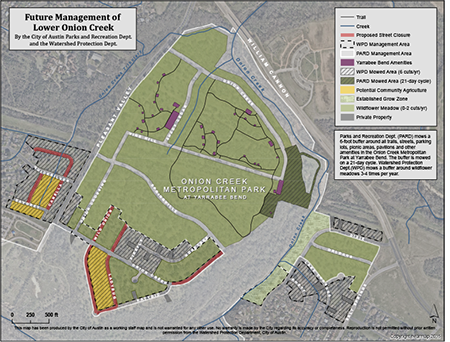Our Operations Branch manages vegetation and green infrastructure at properties owned or managed by the Austin Watershed Protection.
Mowing and Asset Management
From stormwater ponds and open space to creeks and engineered channels, we own thousands of assets. Routine maintenance at these sites includes mowing four times a year, tree trimming and general site cleanup. Along creeks, we focus on removing debris that may block the flow of water.
We manage:
- 45 creeks and tributaries, adding up to more than 90 miles.
- More than 700 acres of land
- Approximately 850 stormwater ponds are in residential areas.
Read more about Green Infrastructure Management.
Alternative Vegetation Management Strategies
We customize the vegetation management at some of our properties to reduce costs and emissions associated with mowing, provide pollinator habitat, increase biodiversity, and promote healthy watersheds.
- Wildflower Meadows
-
Wildflower meadows are areas where we encourage wildflowers and native grasses to become established. Some sites are chosen because of a large existing native plant population. Other sites are chosen due to prior planting history, neighborhood support, or location.
Wildflower meadows are not mown until the mid-to-late summer to allow the native seed heads to mature. Some sites are also seeded if they need a boost in their wildflower population. However, we will continue to mow four times a year along sidewalks, paths, and fence lines to maintain the right of way, line of sight, and to keep a clean border between neighboring properties.
Please keep in mind that wildflower meadows will look different throughout the year, with blooms generally occurring in the spring. At other times, they may look dead or overgrown, but these seasons are important for the health of the plants, quality of the habitat, and success of the meadows.
- Grow Zones
-
A Grow Zone is an area along a creek, where we are encouraging a forested area with diverse trees and plants. This improves water quality, lessens erosion and increases wildlife habitat. Grow Zones can also help combat problems such as the urban heat island effect and climate change.
How do we create a Grow Zone?
First, we stop mowing. This allows the area to begin to heal ecologically and a forest to begin growing. The first plants are pioneers that can withstand the degraded soils and harsh conditions created by mowing. Thanks to birds and wind, Hackberry and Cedar Elm will start growing. In some sites, you can also see baby pecans and oaks braving their way into the world.
At many sites, we also have to plant seedlings. Areas that were mowed for decades tend to have a very limited set of tree species without this extra help. In partnership with TreeFolks, we generally host Ready! Set! Plant! volunteer events in the fall and winter to plant between 25 to 30 different species of trees and shrubs. We plant one tree every three feet, and water them only at the time of planting. Then, the seedlings are left to fend for themselves. We expect some to die, but enough should survive to allow for more diverse vegetation.
- Open Space
-
The Austin Watershed Protection owns property around the city that is designated as open space. This open space can be acquired from property donations, voluntary home buyouts, or because the property contains stormwater infrastructure (such as ponds). We assume vegetation management responsibilities at most of these sites.
We often work with neighborhood groups and partner organizations on collaborative stewardship and land management of many of these properties. With this kind of coordination, it’s possible to have wildflower meadows, restoration areas, community gardens, orchards, or even low-impact trails.
One of our largest tracts of land is along Onion Creek, a former neighborhood near William Cannon Drive and South Pleasant Valley Road. To protect families from flooding, Watershed Protection purchased 815 flood-prone properties between 1999 and 2021.
The area has been converted into open space for public use. Part of the land is now the Onion Creek Metropolitan Park at Yarrabee Bend, which features many covered picnic areas, trails, an off-leash dog area and a playground.
The rest is maintained by the Austin Watershed Protection as open space.

Partnerships
We partner with several nonprofits to help promote our missions and to create green jobs. Some of these nonprofits have volunteer opportunities. We love getting the community’s help in being sustainable stewards of our land!
- Austin Civilian Conservation Corps: This program helps with workforce development. The ACCC team works with multiple departments. They perform restoration work on Watershed Protection lands.
- Keep Austin Beautiful: We support Keep Austin Beautiful’s volunteer cleanup events and their Adopt-a-Creek program.
- The Other Ones Foundation: They help clean up trash, remove invasive species, and beautify our properties, as well as providing jobs to people experiencing homelessness.
- TreeFolks: We support TreeFolks’ Ready! Set! Plant! volunteer events in our Grow Zones and floodplains.

